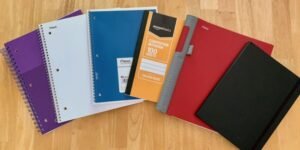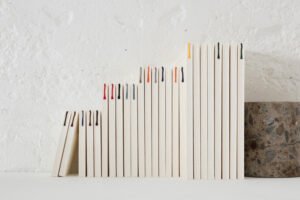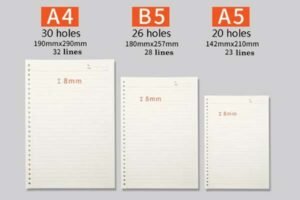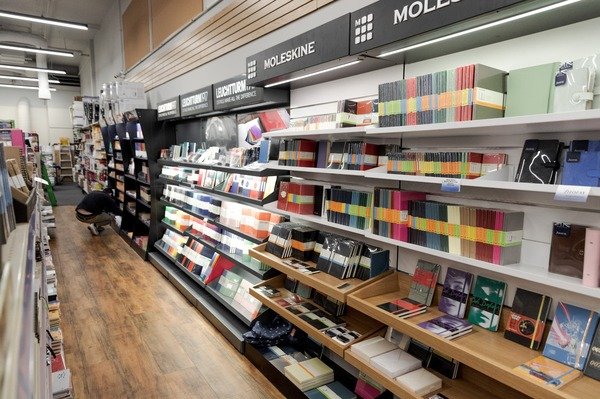
Finding the perfect notebook can feel overwhelming with so many options. Choosing the wrong one leads to frustration – pages bleeding through or a binding that doesn't suit how you work. Let me guide you through making the right choice.
To choose the right notebook, first consider its main purpose (notes, journaling, sketching). Then, look at paper quality (weight, acidity), binding style (lay-flat, durable), notebook size (portability), and cover type (protection, style).
Selecting a notebook is more than just picking a cover design. The right notebook enhances your writing or drawing experience. Think about how you'll use it most often. Will it live on your desk, or travel in a bag? Do you use fountain pens that need thicker paper, or pencils for quick sketches? Considering these basic factors ensures the notebook works for you, not against you. It makes the difference between a tool you love and one that gathers dust.
Let's break down these key elements. Purpose dictates many other choices. Daily journaling might need durable binding and good paper. Meeting notes might prioritize portability and standard ruling. Sketching demands specific paper types and perhaps lay-flat binding. Understanding your primary need is the essential first step before diving into the specifics of paper, binding, size, and cover materials.
What Paper Quality Should I Look For?
The paper inside is the heart of your notebook. Choosing the right paper quality makes a huge difference in your writing or drawing enjoyment.
Look for paper weight (gsm) suitable for your writing tools, acid-free paper for longevity, and a finish (smooth, textured) that matches your preference. Consider the ruling format (lines, dots, grid, blank) based on your primary use.

Paper Quality
Let's explore these paper characteristics in more detail. Getting these right prevents common issues like ink bleeding or feathering, and ensures your notes last.
Understanding Paper Weight (GSM)
GSM stands for "grams per square meter." It tells you how thick and heavy the paper is.
- 70-80 gsm: This is standard for everyday notebooks and copy paper. It's fine for ballpoints and pencils, but heavier inks like fountain pens or markers might show through (ghosting) or even bleed through. We often use this weight for bulk orders like school notebooks where cost is a major factor.
- 100-120 gsm: A significant step up. This weight handles most pens, including fountain pens and markers, with much less ghosting or bleed-through. It feels more substantial and premium. We recommend this for business journals or quality personal notebooks. We can easily upgrade from 80gsm to 100gsm for a small cost increase, around $0.07 per book.
- 120+ gsm: Often used for sketching or art notebooks. This heavier paper can handle wetter media like ink washes or light watercolor. Think European sketch paper or specialty papers.
Here’s a simple guide:
| GSM Range | Common Use Cases | Ink Handling |
|---|---|---|
| 70-80 gsm | General notes, drafts, schools | Basic pens, pencil |
| 90-100 gsm | Journaling, meetings, fountain pens | Good |
| 120 gsm+ | Sketching, art, heavy ink use | Excellent |
| Specialty (e.g., Tomoe River 52/68gsm) | Fountain pen enthusiasts (thin but resistant) | Very Specific |
Why Acid-Free Paper Matters
Have you seen old books with yellow, brittle pages? That's often due to acid in the paper. Acid-free paper is manufactured using alkaline processes, neutralizing acids. This means the paper resists degradation over time. If you're archiving notes, journaling for memory keeping, or creating something meant to last, always choose acid-free paper. Most quality notebooks, including ours, use acid-free paper (like our 80-120g options) as standard.
Paper Finish and Ruling
- Finish: Refers to the paper's surface texture. Smooth finishes are great for gel pens and ballpoints, providing effortless glide. Papers with more "tooth" (a slight texture) grab graphite better, ideal for pencil work or sketching.
- Ruling: This is the printed guide on the page.
- Lined: Standard for writing notes.
- Grid: Great for diagrams, bullet journaling, or structured notes.
- Dot Grid: A flexible alternative to grids, less intrusive but still provides guidance. Very popular for bullet journals.
- Blank: Best for sketching, drawing, or freeform notes.
We can print any of these formats, and even add page numbers or corner rounding for a more finished look. We also offer options like Japanese Tomoe River paper for specific needs.
Which Notebook Binding Method is Best?
How your notebook is held together affects how it opens, how durable it is, and how comfortable it is to use. There's no single "best" method; it depends on your needs.
Choose spiral/coil binding for 360° folding and lay-flat ease. Select stitched or glued binding for a durable spine and professional look. Opt for binder systems if you need flexibility to add, remove, or rearrange pages.

Binding Methods
Let's look at the common types and their pros and cons. We manufacture various styles, so I've seen firsthand how each performs.
Spiral, Wire-O, or Coil Binding
This involves punching holes along the spine edge and inserting a metal or plastic coil.
- Pros: Notebooks lay perfectly flat (180°) or can fold back on themselves (360°). This is great for limited desk space or taking notes while standing.
- Cons: The coil can sometimes get crushed in a bag. It might feel less formal than other bindings. Some find the coil bumps interfere slightly with writing near the spine.
- Our approach: We developed a patented "seamless coil" technology that provides a smoother 360° touch and avoids snagging clothes, addressing a common annoyance.
Stitched and Glued Binding (Perfect Bound, Smyth Sewn)
Pages are gathered into sections (signatures), which are then either sewn together (Smyth sewn) or glued directly to the spine (perfect bound), often with a cover wrapped around.
- Pros: Creates a clean, book-like spine. Generally durable, especially Smyth sewn which is very strong. Looks professional.
- Cons: May not lay perfectly flat right out of the box, especially perfect bound ones. Some require "breaking in" the spine.
- Our approach: We use German Heidelberg glue binders for strong perfect binding. For clients needing true lay-flat capability with this style, like a German chain bookstore we worked with, we developed FSC-certified notebooks using a specialized bare spine binding that allows a 180° flat opening. We also offer tear-proof reinforcement for educational notebooks.
Ring Binder Systems
These aren't technically bound notebooks but systems using metal ring mechanisms (like Filofax or our own binders) that clamp onto punched paper.
- Pros: Highly flexible – you can add, remove, and reorganize pages easily. You can mix different paper types or inserts (calendars, dividers).
- Cons: Can be bulkier than traditional notebooks. The rings themselves can sometimes get in the way of writing. Requires specifically punched paper.
- Our approach: We manufacture high-quality metal binders (using 304 stainless steel rings or aluminum clips with rust-proof electroplating) compatible with international standards (6-hole, 20-hole, 26-hole like Filofax and Kokuyo Campus). This allows users great flexibility with refills.
Considerations When Choosing
- Lay-flat need: Is it essential for the notebook to lie completely flat without holding it down? (Spiral/Coil or specialized sewn bindings are best).
- Durability: Will the notebook endure rough handling? (Smyth sewn is typically the most durable).
- Page rearrangement: Do you need to add or move pages? (Binder system is the only option).
- Aesthetics: What look are you going for? (Stitched/glued often looks more traditional or professional).
How Do Notebook Size and Cover Affect Usability?
The physical dimensions and the outer shell of your notebook play a big role in how practical it is for your specific situation. Size impacts portability, while the cover provides protection and personal style.
Choose a notebook size based on where and how you'll use it (pocket for on-the-go, A4/Letter for desk work). Select a cover for durability (hardcover) versus flexibility (softcover) and your desired look (material, customization options).
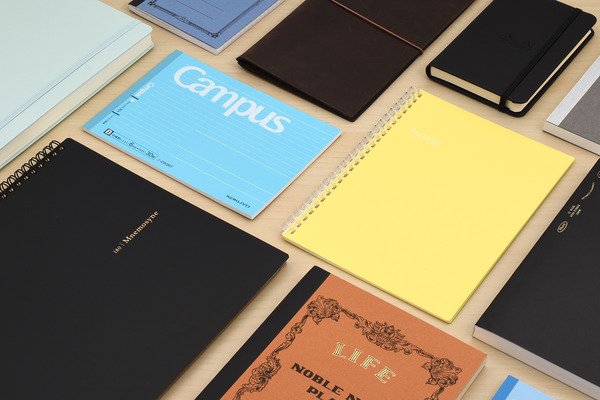
Size and Cover Options
Let's break down common sizes and cover types to help you match them to your needs.
Common Notebook Sizes
Notebook sizes often follow international paper standards (like the A, B series) or regional standards.
| Size | Dimensions (approx.) | Common Use Cases | Portability vs. Writing Space |
|---|---|---|---|
| Pocket (A6) | 4.1 x 5.8 in / 10x15 cm | Quick notes, ideas on the go, fits in pocket | High portability, limited writing space |
| B6 | 4.9 x 6.9 in / 12x18 cm | Popular for journaling, portable yet decent space | Good balance |
| A5 | 5.8 x 8.3 in / 15x21 cm | Very common for journaling, planning, meetings | Good portability, ample writing space |
| B5 | 6.9 x 9.8 in / 18x25 cm | Less common but great desk size, spacious | Less portable, very generous writing space |
| A4 / Letter | 8.3 x 11.7 in / 21x30 cm | Schoolwork, extensive notes, desk use | Low portability, maximum writing space |
We frequently customize notebooks to standard sizes like A5 and B6, but also handle special requests like passport-sized or custom shapes for creative industries. The key is balancing how much space you need to write or draw with how easy it needs to be to carry around.
Cover Materials and Types
The cover protects the pages inside and contributes significantly to the notebook's feel and look.
- Hardcover: Offers excellent protection for the pages, provides a sturdy writing surface even without a table. Looks professional and durable. Can be covered in various materials (paper, cloth, PU leather).
- Softcover: More flexible and lightweight than hardcover. Easier to fit into tight spaces in a bag. Often less expensive. Can be made from heavy cardstock, flexible plastic (like PP), or thinner leatherette.
- Special Materials: We work with various options:
- Cloth hardcover: Offers a tactile, premium feel.
- PU Leather: Provides a classic look, durable.
- Recycled Materials: We offer options like bagasse fiber covers (made from sugarcane waste) for eco-conscious clients.
- PP Plastic: Durable, water-resistant, available in various colors, can be degradable.
Customization Options
The cover is also prime real estate for branding or personalization. Common techniques we offer include:
- Hot Stamping: Applying metallic foil or colored pigment using heat and pressure. Great for logos and titles ($0.08/unit).
- Embossing/Debossing: Creating a raised (emboss) or recessed (deboss) impression on the cover material ($0.15/unit). Adds a subtle, tactile elegance.
- Laser Engraving: Using a laser to etch a design onto the cover, works well on materials like metal, wood, or certain plastics ($0.12/unit). Common for our metal binders.
- Printing: Full-color printing allows for complex graphics or branding. We use eco-friendly soy ink options.
Choosing the right cover involves balancing durability needs, desired aesthetic, potential customization, and budget.
Finding a Manufacturing Partner You Can Trust
Now that you understand the key elements of choosing a notebook – purpose, paper, binding, size, and cover – you might be looking for someone to help bring your ideal notebook to life, especially if you need customization or bulk quantities.
As NotebookRing®, we've been focused solely on manufacturing high-quality notebooks and binders since 2006. Based in Wenzhou, China, our 15,000㎡ FSC-certified factory houses 8 production lines capable of producing over 500,000 notebooks monthly. We control the entire process, from our own special paper processing to metal stamping workshops. This vertical integration allows us to ensure quality (meeting ISO 9001, BSCI, REACH standards) and offer competitive pricing (regular notebooks $0.63-$1.70 depending on quantity).
We specialize in tailored solutions: customized designs (covers, paper, binding), specific materials (acid-free, recycled, Tomoe River, 304 stainless steel rings), and industry-specific notebooks (education, corporate gifts, creative fields). We understand the nuances discussed here because we help clients like German bookstores needing FSC-certified lay-flat books, Silicon Valley tech firms requiring laser-engraved gift sets, and Japanese brands developing specialized notebooks navigate these choices every day. We support flexible orders (starting from 100 units for samples) and offer global logistics solutions.
Conclusion: Choose Wisely for a Better Experience
Choosing the right notebook comes down to matching its features – purpose, paper, binding, size, and cover – to your specific needs and preferences. Taking a moment to consider these factors ensures you get a tool that enhances your writing, thinking, or creative process.

